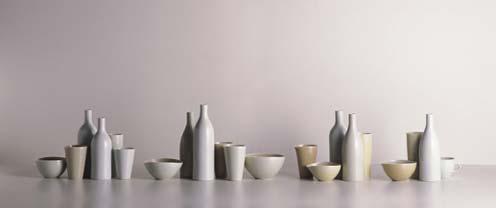5 exhibitions
dal 19/5/2004 al 26/9/2004
Segnalato da
David Nash
Gwyn Hanssen Pigott
Mike Marshall
Mariele Neudecker
Barbara Hepworth
Ben Nicholson
Naum Gabo
Roger Hilton
19/5/2004
5 exhibitions
Tate St Ives, St Ives (Cornwall)
David Nash is an artist of individuality and distinction. Internationally renowned for working with wood to form large dramatic and tactile sculptures, this new exhibition highlights the distinctive geometric theme in Nash's work. Caravan is the first major touring exhibition by this Australian artist in the UK. Gwyn Hanssen Pigott worked with Bernard Leach in the 1960s prior to setting up her pottery in Australia. Mike Marshall: An inventive and humorous video – The Earth is Flat - lulls the viewer into what can been described as 'focused daydreaming' in a desolate environment, while a sound work on the cafe' terrace introduces exotic elements from elsewhere. Artists of the Saint Ives School. The essential image: A selection from the Tate collection, including Barbara Hepworth, Ben Nicholson, Naum Gabo and Roger Hilton. Mariele Neudecker creates landscapes, often evocations of mountain ranges, which are made of fiberglass resin airbrushed with acrylic and placed in glass cases.

David Nash
20 May - 26 September 2004
Supported by the Henry Moore Foundation
David Nash (b 1945) is an artist of individuality and distinction. Internationally renowned for working with wood to form large dramatic and tactile sculptures, this new exhibition highlights the distinctive geometric theme in Nash's work. The act of cutting, so integral a part of Brancusi's ambitions as a sculptor, soon became Nash's favoured way of working. But wood was his sole material, hewn from unseasoned trees, the forms assumed were primary, based on the fundamental geometry of the cube, the sphere and the pyramid. Nash warms to the universality of these shapes; they belong to no one, and cannot be violated. In his mind, the cardinal directions for mark-making apply to his favoured forms: vertical for the cube, horizontal for the sphere, and diagonal for the pyramid. While recognising Plato's theory that we know these forms from the spiritual world, Nash feels that geometry has been deadened by materialism and that 'there is a task to re-enliven its experience'. He still sees making art as a religious activity, even if his boyhood Anglicanism was long ago supplanted by a non-denominational interest in all faiths, Buddhism in particular. He believes passionately in the sanctity of free will, and applies it continually in his engagement with the interaction between human consciousness and nature.
Characterised by inorganic, non-allusive form present in his sculpture from the early wooden constructions in the 1960s to the present day, the exhibition includes an exciting range of works including eight major sculptures exploring the sphere, pyramid, cube and column, as well as a gestural wall drawing that accompanies the premiere of a film documenting Boulder, a work of land art begun in 1978. The film charts the passage over 26 years of this large wooden sphere from the interior landscape of North Wales across the Dwyryd Estuary and on into the Atlantic Ocean. Shown in the context of the Modernist school of artists, the exhibition reconsiders Nash's process and philosophy and offers an exciting new dynamic to the presentation of his work.
As part of Artists on Artists, three works from the Tate Collection by Alberto Giacometti, who Nash cites as an influence, will be shown alongside the exhibition.
----
Gwyn Hanssen Pigott
caravan
20 May - 26 September 2004
Caravan is the first major touring exhibition by this Australian artist in the UK. Gwyn Hanssen Pigott worked with Bernard Leach in the 1960s prior to setting up her pottery in Australia. She is renowned for the abstract simplicity of her off-white porcelain pots, inspired by the work of modernist potters Bernard Leach and Hans Coper, as well as the still-life paintings of Giorgio Morandi. In an extraordinary 55' still-life installation, the physical and psychological potential of the pot is expressed to its fullest potential. Since the 1980s she has evolved 'inseparable' groups of translucent porcelain forms, which create a dynamic with one another and the viewer.
This project has been assisted by the Australian Government through the Australia Council, its arts funding and advisory body. Also supported by Tate St Ives Members.
----
Mike Marshall
Here is fine
20 May - 26 September 2004
An inventive and humorous video – The Earth is Flat - lulls the viewer into what can been described as 'focused daydreaming' in a desolate environment, while a sound work on the café terrace introduces exotic elements from elsewhere. Mike Marshall uses sound as an aesthetic sonar to map out and form space in both of the works on display.
----
Artists of the Saint Ives School
The essential image
20 May - 26 September 2004
Throughout the 20th century, many artists have sought to express their ideas through the essential elements of painting and sculpture: line, shape, scale mass, colour and texture. Artists in St Ives were at the forefront of this movement in Britain, and established a focus for modern art in the area. A selection from the Tate collection, including Barbara Hepworth, Ben Nicholson, Naum Gabo and Roger Hilton.
----
Mariele Neudecker
22 May - 26 September 2004
Mariele Neudecker (b.1965) left Germany in the 1980s and now lives and works in Bristol. She creates landscapes, often evocations of mountain ranges, which are made of fiberglass resin airbrushed with acrylic and placed in glass cases. The essence of her work is an exploration of the territory between reality, imagination, experience and memory, and central to her practice is her interest in German Romanticism.
Image:
Gwyn Hanssen Pigott
Caravan, 2002
© the Artist
Tate St Ives
Porthmeor Beach
St Ives
Cornwall
TR26 1TG
Telephone: 01736 796226 (international +44 1736 796226)



